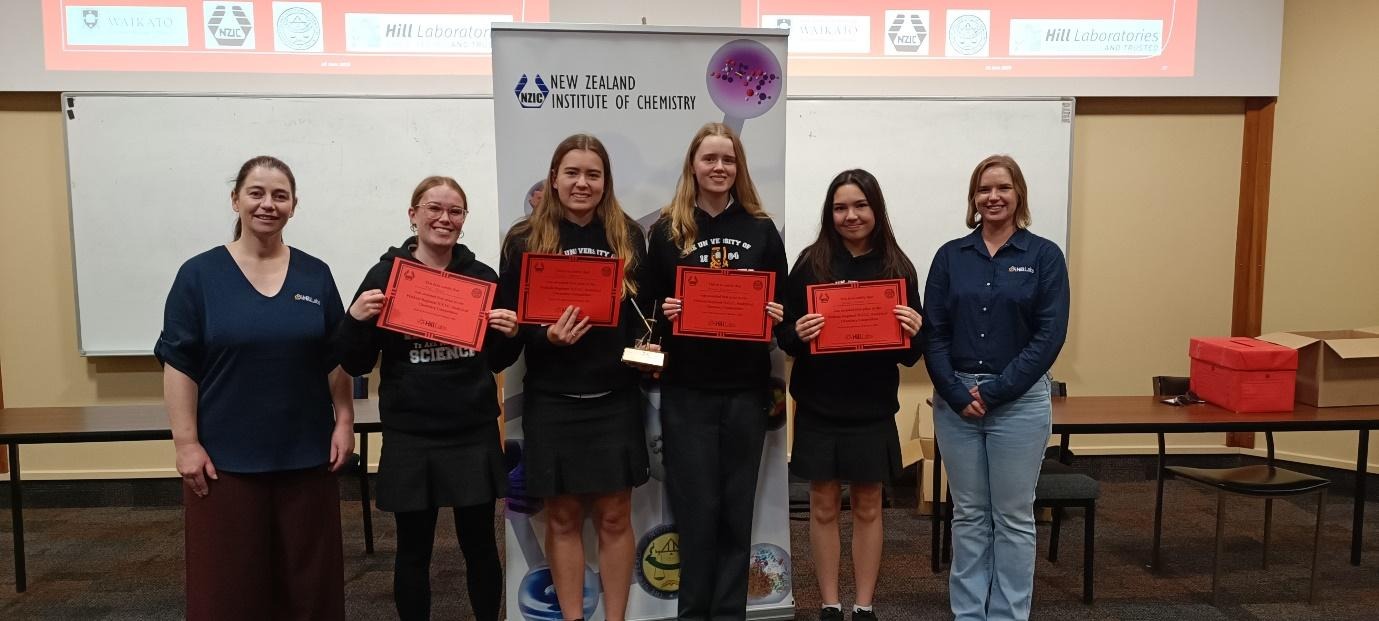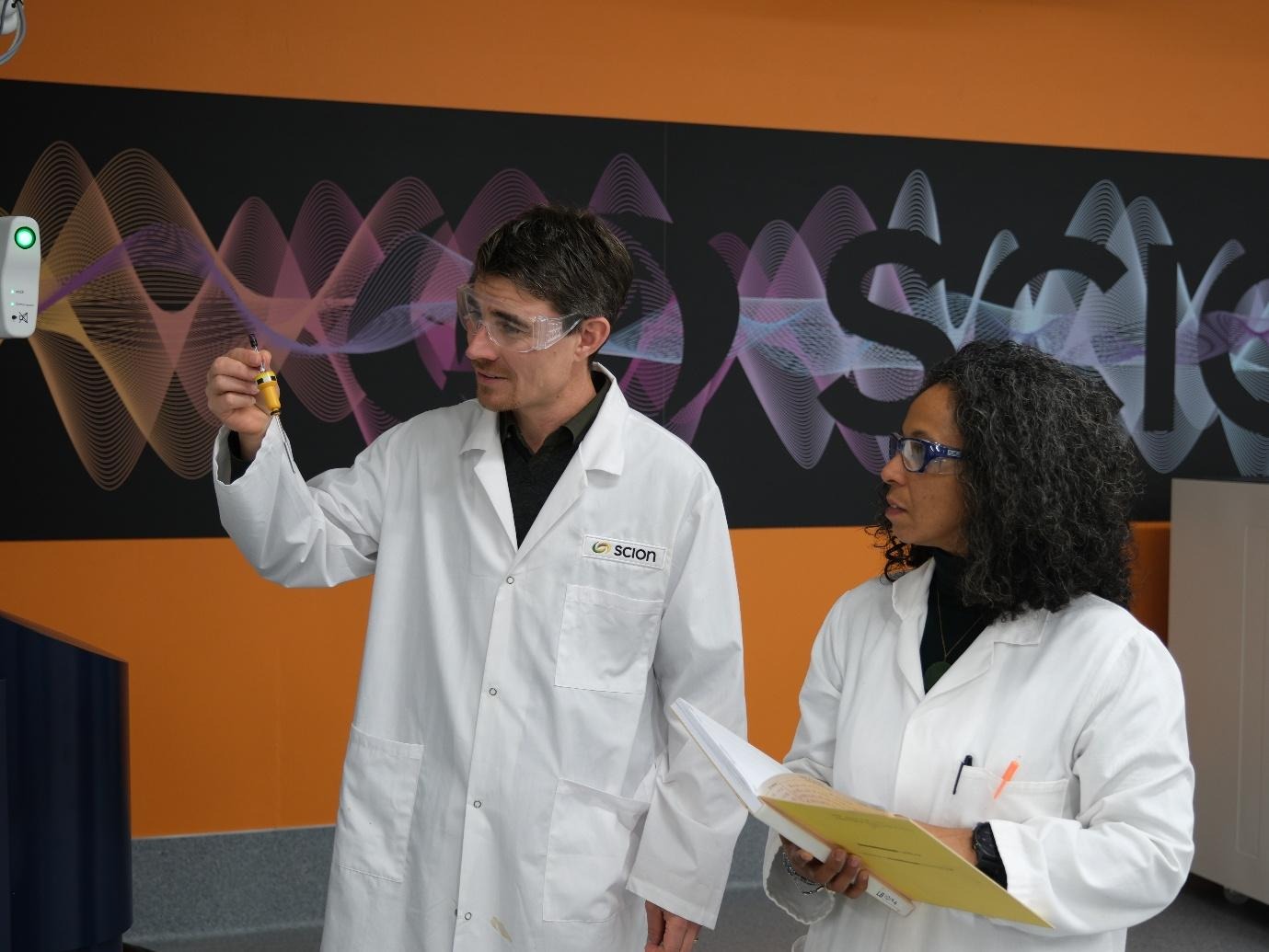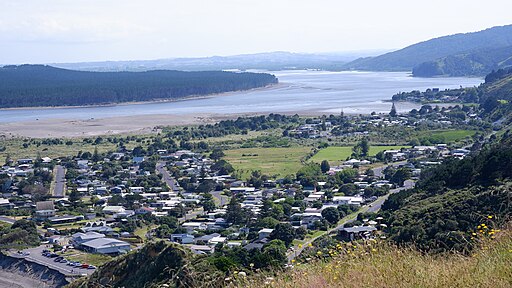NZIC Analytical Chemistry Competition 2025
This annual event was held on 10 June. 24 teams of students from 23 schools across the Waikato/Bay of Plenty/South Auckland regions sent teams of four students to the university for the day to carry out the analysis for this year’s competition.
“The task was to analyse the individual levels of barium and chloride ions in a sample of barium chloride and to use these values to determine how many water molecules were associated with each barium chloride molecule. One pair from each group of four analysed their samples to determine the barium ion content, while the other half of the team determined the chloride ion level. Although this was quite a challenging task in the time available, it was very close between the top few teams,” said competition judge and key organiser, Michèle Prinsep.
The competition allowed enthusiastic Year 13 chemists to spend a day in the university laboratories working on an experiment that would be beyond the resources of their schools. Although competition was intense, the main emphasis was on enjoying the experience of working in a chemistry laboratory at the university and meeting students from other schools. The winning team received $280 and a trophy, with prize money also awarded to all other placegetters thanks to the generosity of the sponsors.
The day involved many of the chemistry department staff in setting up the competition and supervising the labs. Bryant Hall and Student Village provided excellent lunches (sponsored by the Waikato Branch of the NZIC), while Hill Laboratories and the Waikato Branch of the NZIC generously donated the prizes.
Results were:
1st Prize: Mount Maunganui College (Amaya Greene, Mia Olsen, Skye Shaw, Shiloh Warner)
2nd Prize: Hamilton Boys' High School (Jonathan Crowther, Andrew Kim, Nikash Lanka, Conor McCormack)
3rd Prize: Tauranga Girls' College (Tanisha Bhika, Kyla Chen, Jasmine Kaur, Paige Rickard)
4th Prize: Waikato Diocesan School for Girls 1 (Haneul Choi, Jacqueline Li, Joy Liao, Zoe Ter Beek)
5th Prize: St Peter's School (Nikhil Jogia, Nathan Kurien, Angus MacGillivray, Dennis Weir)

Science Fair
The Waikato branch of NZIC again sponsored the Waikato Regional Science Fair and two special prizes in chemistry. The award for the best junior chemistry investigation went to Methindu Udahadeniya of Peachgrove Intermediate School for his project, “Voracious vitamin C” and the award for the best senior chemistry investigation went to Annabelle Martin of St Peter's School for her project, “Scraps to plastics”.
University of Waikato
We welcomed the following new PhD students:
Jiaming Liu: “Synthetic studies towards denigrins H-L and sulfated analogues” (supervisors: Ben Dickson, Michèle Prinsep).
Pathmini Madushani Dissanayaka Mudiyanselage: “Studies towards novel inhibitors of bacterial DNA ligases” (supervisors: Ben Dickson, Adele Williamson).
Jamie Li: “The chemistry of flora of the Chatham Islands” (supervisors: Michèle Prinsep, Peter de Lange [Unitec], Margaret Barbour).
Mehreen Fatima: “Synthesis, characterisation and performance of nanoparticles prepared via reverse microemulsion as precursors for HEA electrocatalysts” (supervisors: Michael Mucalo, Fei Yang [Engineering]).
Bo Borbridge: “At the limit: 14C dating the Aboriginal occupation of Australia” (supervisors: Fiona Petchey [Waikato Radiocarbon Laboratory], Michael Mucalo, Peter Veth [University of Western Australia]).
Kavitha Ranaweera, who completed her PhD earlier this year with Michael Mucalo, is now working at SGS in Waihi as an analyst. Mohammad Soleimani Zohr Shiri recently completed his PhD with Micheal Mucalo and has secured a role at Analytica, Ruakura, after doing some consultancy work in the university.
Fonterra
As part of the Easterfield Award, Brendon Gill completed visits to UK universities, giving a presentation, "Development of international reference methods for the analysis of micronutrients in infant formula" at the University of Reading, Manchester Metropolitan University, and the University of Aberdeen.
Hill Labs
Hill Labs has introduced a new Environmental DNA (eDNA) Water Testing service that enables the identification of organisms in freshwater environments by analysing trace DNA found in water samples. This non-invasive method supports ecological monitoring and biosecurity efforts by providing insights into biodiversity and environmental changes without disturbing habitats.
Hill Labs has launched a mould testing service designed to detect and identify mould species in indoor environments, supporting health, safety, and building integrity assessments. The service includes surface and air sampling methods and integrates with existing asbestos and meth testing workflows to streamline environmental testing processes.
Bioeconomy Science Institute
International black soldier fly larvae research gets $3m funding boost

Bioeconomy Science Institute researchers have $3 million in funding to investigate the potential of black soldier fly larvae (BSFL, Hermetia illucens) to produce health-promoting ingredients for humans.
The study taps into a growing interest in using insects to turn waste into high-value products and beneficial compounds such as antioxidants and anti-inflammatory agents that can positively impact human health. Project lead Dr Jamie Bridson, of the Scion Group of the Bioeconomy Science Institute, says this complements other current research, which focuses on using black soldier fly larvae to convert organic waste into high-quality protein for animal feed.
“These larvae are like little bio-factories,” Jamie says. “By adjusting what they eat and how we raise them, we can influence the natural compounds they produce that could be valuable for human health. We can process them to recover useful ingredients from the larvae while still keeping the leftover material suitable as high-protein animal feed. It’s about adding value at every step.”
Over the next three years, researchers will examine breeding, feeding and housing conditions to improve larval health and the quality of the beneficial substances they produce. The project will also explore efficient extraction methods, assess economic viability and study what consumers want from insect-based products.
The Scion Group is collaborating with Plant & Food Research – also a group within the Bioeconomy Science Institute – and Natural Extraction Technologies in New Zealand on the project, alongside partners at the National University of Singapore (NUS) and Singapore’s Agency for Science, Technology and Research (A*STAR).
The project will use key infrastructure, including a pilot rearing facility at Plant & Food Research that supports the development and testing of insect farming at scale. Researchers will also utilise the Scion Group’s upgraded Nuclear Magnetic Resonance suite (a valuable asset for analysing plant and bio-based substances) and the National University of Singapore’s advanced insect rearing chambers, which help improve insect farming systems and optimise how the larvae are grown and processed.
“A portion of the funding will be used to replicate the insect chamber setup in New Zealand,” Jamie says. “It would allow us to mirror trials across both countries and speed up research by testing in different environments.”
The overall goal is to prove this approach is scientifically sound, economically viable and market-ready. “If we can show these insects can help reduce waste and support human health, it could open the door to a whole new kind of sustainable food system,” Jamie says.
This project, jointly administered by New Zealand’s Ministry of Business, Innovation and Employment (MBIE) and A*STAR, supports collaborative research in advanced biotechnology solutions for future food systems.
Funding has been awarded through the New Zealand–Singapore Catalyst: Strategic Biotech in Future Food Research Programme.
Biofuel innovation set to make waves in marine shipping

Biofuel technology that promises to help reduce the marine shipping industry’s carbon footprint is a step closer, with the launch of a company set up to lead its commercialisation.
Start-up venture Biowave, launched in Wellington on August 13, will focus on attracting private investors to help commercialise the technology – which converts wood into biofuel that can be used as a drop-in replacement for fossil-based marine heavy fuel oil. Developed by the Bioeconomy Science Institute, this innovation produces a biofuel that blends with existing marine fuel oil, aimed to use existing portside and on-board infrastructure and to meet the existing marine fuel specifications.
Biowave is a spin-out company from the Bioeconomy Science Institute, with two staff – Integrated Bioenergy portfolio leader Dr Paul Bennett and innovation manager Amanda Davies – its co-founders. Paul says the biofuel technology is a promising solution to reducing the shipping industry’s carbon footprint. “With the global shipping sector responsible for around three percent of annual CO2 emissions, the need for sustainable alternatives has never been more urgent.
“We are committed to driving down biofuel costs and accelerating clean energy innovations for the maritime sector. Major exporters are increasingly concerned about the carbon emissions linked to their products, with market access becoming a real risk. The technology has the potential to make a substantial contribution to the maritime industry’s decarbonisation goals.”
Shipping is an essential component of global trade, moving 80 percent of the world’s goods. For New Zealand, 99 percent of international trade depends on maritime routes, with shipping enabling nearly 45 percent of the country’s gross domestic profit. “As demand for shipping increases, the sector’s carbon footprint is on track to rise, potentially accounting for up to 13 percent of global emissions in the coming decades if no action is taken,” Paul says.
Fuel testing of a 20 percent Biowave blend has excited industry partners and could represent a product suitable for entry in the marine fuel market. Scale-up production and engine testing will be required to confirm market acceptance.
“The maritime industry is actively seeking solutions, and we’ve seen significant interest in Biowave from key stakeholders across the supply chain, including shipping companies, energy providers, ports and product exporters,” Amanda says.
“This technology offers a cost-competitive, sustainable solution for New Zealand’s economy and could be scaled globally. With strong market validation and a clear path to market, Biowave is set to make a lasting impact on New Zealand’s economy and the maritime industry to meet 2050 climate commitments.”
The Scion Group’s leadership in this space is reinforced by its participation in the KiwiNet Commercialisation Partner Network, which aims to drive the commercial success of research innovations in New Zealand.
The commercialisation of sustainable marine biofuel technology could deliver significant environmental and economic benefits to New Zealand. Onshore production of biofuels would help the country meet its greenhouse gas reduction targets, reduce the carbon intensity of exports and safeguard market access for the $70 billion of New Zealand’s exports that rely on shipping. The development of biofuel production plants in regions such as Northland, the East Coast and the Central North Island would also stimulate local economies and create jobs, particularly in areas with strong forestry operations.
By leveraging its abundant forestry resources, New Zealand has the potential to reduce its shipping emissions by 2050 through the widespread deployment of small-scale conversion plants situated between forests and ports. This scalable model addresses the domestic market and could be exported to other forestry-rich regions globally, such as North America and Europe, amplifying its impact on the global shipping industry.
As regulatory bodies such as the International Maritime Organisation set aggressive decarbonisation targets, such as cutting industry emissions to zero by 2050, there is growing demand for sustainable alternatives to fossil fuels. Experts predict that by 2030, global demand for carbon-neutral marine fuels could reach 17 million tonnes. That’s equivalent to 30-40% of expected global biofuel production capacity in 2030, just for the shipping sector.
Despite this, biofuels currently comprise less than 0.1% of the fuels used in shipping, highlighting a significant gap in supply and a ripe opportunity for new market entrants. Scion estimates that producing 200,000 tonnes of biofuel initially presents a $600 million manufacturing opportunity for New Zealand.
New Zealand exporters such as Zespri are among those keen to investigate low-emissions shipping as a critical part of carbon reduction for Kiwi exporters who need to protect market access. “We support investment in biofuel supply production in New Zealand,” says Zespri chief supply chain officer Tim Mackle.
“New Zealand has a unique opportunity to drive this work and lead pilots and trials, which will require setting up the right regulatory framework and solid demand. Already used widely in aviation, biofuel is an important step in the decarbonisation of international shipping, as it is a “drop in fuel” that can be used in conventional vessels, requires no engine modification and can reduce carbon emissions up to 20 percent (depending on the blend used).”
Global ports such as Singapore and Rotterdam have already embraced biofuels, with increasing numbers of shipping companies – including CMA-CMG, Maersk and Hapag-Lloyd – committing to net-zero targets by 2050.
Port of Tauranga CEO Leonard Sampson said biofuels would have a significant role in the future supply chain. “Port of Tauranga is committed to decarbonising its business as well as supporting customers on their decarbonisation journey. We want to ensure our customers have all the options they need as shipping transitions to a lower emissions future.”
About the Bioeconomy Science Institute
The Bioeconomy Science Institute brings together AgResearch, Manaaki Whenua - Landcare Research, Plant & Food Research and Scion into a single organisation, conducting research to advance innovation in agriculture, horticulture, aquaculture, forestry, biotechnology and manufacturing, protect and enhance ecosystems from biosecurity threats and climate risks and develop new bio-based technologies and products. For more information visit wwwbioeconomyscience.co.nz




-1200x800-5b2df79.jpg)

